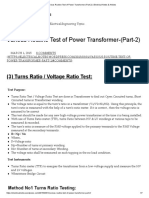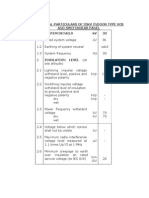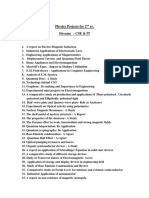Method No: 2 (Current Voltage Method of Measurement of Winding Resistance)
Method No: 2 (Current Voltage Method of Measurement of Winding Resistance)
Uploaded by
Hassan AbdoCopyright:
Available Formats
Method No: 2 (Current Voltage Method of Measurement of Winding Resistance)
Method No: 2 (Current Voltage Method of Measurement of Winding Resistance)
Uploaded by
Hassan AbdoOriginal Description:
Original Title
Copyright
Available Formats
Share this document
Did you find this document useful?
Is this content inappropriate?
Copyright:
Available Formats
Method No: 2 (Current Voltage Method of Measurement of Winding Resistance)
Method No: 2 (Current Voltage Method of Measurement of Winding Resistance)
Uploaded by
Hassan AbdoCopyright:
Available Formats
Test Procedure:
The main principle of bridge method is based on comparing an unknown
resistance with a known resistance.
When electric currents flowing through the arms of bridge circuit become
balanced, the reading of galvanometer shows zero deflection that means at
balanced condition no electric current will flow through the galvanometer.
Very small value of resistance (in milliohms range) can be accurately
measured by Kelvin Bridge method whereas for higher value Wheatstone
bridge method of resistance measurement is applied. In bridge method of
measurement of winding resistance, the error is minimized.
All other steps to be taken during transformer winding resistance measurement
in these methods are similar to that of current voltage method of measurement
of winding resistance of transformer
Method No: 2 (current voltage method of measurement of winding resistance)
Test Procedure:
The resistance of each transformer winding is measured using DC current and
recorded at a ambient temp.
In this test resistance of winding is measurement by applying a small DC
voltage to the winding and measuring the current through the same
The measured resistance should be corrected to a common temperature such as
75C or 85C using the formula: RC=RM x ((CF+CT)/(CF+WT))
where
RC is the corrected resistance, RM is the measured resistance
CF is the correction factor for copper (234.5) or aluminum (225) windings
CT is the corrected temperature (75C or 85C)
WT is the winding temperature (C) at time of test
Before measurement the transformer should be kept in OFF condition at least
for 3 to 4 hours so in this time the winding temperature will become equal to
its oil temperature.
To minimize observation errors, polarity of the core magnetization shall be
kept constant during all resistance readings.
Voltmeter leads shall be independent of the current leads to protect it from
high voltages which may occur during switching on and off the current circuit.
The readings shall be taken after the electric current and voltage have reached
steady state values. In some cases this may take several minutes depending
upon the winding impedance.
The test current shall not exceed 15% of the rated current of the winding.
Large values may cause inaccuracy by heating the winding and thereby
changing its resistance.
For Calculating resistance, the corresponding temperature of the winding at
the time of measurement must be taken along with resistance value.
Required Precaution:
According to IEC 60076-1, in order to reduce measurement errors due to
changes in temperature, some precautions should be taken before the
measurement is made.
For Delta connected Winding: for delta-connected transformer, the
resistance should be measured for each phase (i.e. R-Y , Y-B & B-R) .Delta is
composed of parallel combination of the winding under test and the series
combination of the remaining winding .It is therefore recommended to make
three measurements for each phase to-phase winding in order obtain the most
accurate results.
For Delta connected windings, such tertiary winding of auto-transformers
measurement shall be done between pairs of line terminals and resistance per
winding shall be calculated as per the formula: Resistance per Winding = 1.5
X Measured Value
For Star connected winding: the neutral brought out, the resistance shall be
measured between the line and neutral terminal (i.e. R-N , Y-N,B-N) and
average of three sets of reading shall be the tested value. For Star connected
auto transformers the resistance of the HV side is measured between HV
terminal and IV terminal, then between IV terminal and the neutral.
For Dry type transformers: the transformer shall be at rest in a constant
ambient temperature for at least three hours.
For Oil immersed transformers: the transformers should be under oil and
without excitation for at least three hours. In case of tapped windings, above
readings are recorded at each tap. In addition, it is important to ensure that the
average oil temperature (average of the top and bottom oil temperatures) is
approximately the same as the winding temperature. Average oil temperature
is to be recorded. Measured values are to be corrected to required
temperatures.
As the measurement current increases, the core will be saturated and
inductance will decrease. In this way, the current will reach the saturation
value in a shorter time.
After the current is applied to the circuit, it should be waited until the current
becomes stationary (complete saturation) before taking measurements,
otherwise, there will be measurement errors.
The values shall be compared with original test an result which varies with the
transformer ratings.
Test Acceptance criteria:
DC Resistance Should be<=2% Factory Test.
2
Test Current <10% Rated Current
Test can detect:
Short Turns
Loose Connection of bushing
Loose Connection or High Contact Resistance on Tap Changer.
Broken winding stands
3) Turns Ratio / Voltage Ratio Test:
Test Purpose:
Turns Ratio Test / Voltage Ratio Test are done in Transformer to find out Open
Circuited turns, Short Circuited turns in Transformer winding.
The voltage ratio is equal to the turns ratio in a transformer (V1/V2=N1/N2).
Using this principle, the turns ratio is measured with the help of a turns ratio
meter. If it is correct , then the voltage ratio is assumed to be correct
This test should be made for any new high-voltage power transformer at the
time it is being installed.
With use of Turns Ratio meter (TTR), turns Ratio between HV & LV windings
at various taps to be measured & recorded.
The turns ratio is measure of the RMS voltage applied to the primary
terminals to the RMS Voltage measured at the secondary terminals.
R= Np / Ns
Where,
R=Voltage ratio
Np=Number of turns at primary winding.
Ns= Number of turns at secondary Winding.
The voltage ratio shall be measured on each tapping in the no-load condition.
Test Instruments:
Turns Ratio meter (TTR) to energies the transformer from a low-voltage
supply and measure the HV and LV voltages.
Wheatstone Bridge Circuit
Method No1 Turns Ratio Testing:
Test Procedure:
Transformer Turns Ratio Meter (TTR):
Transformer ratio test can be done by Transformer Turns Ratio (TTR) Meter. It
has in built power supply, with the voltages commonly used being very low,
such as 8, 10 V and 50 Hz.
The HV and LV windings of one phase of a transformer (i.e. R-Y & r-n) are
connected to the instrument, and the internal bridge elements are varied to
produce a null indication on the detector.
Values are recorded at each tap in case of tapped windings and then compared
to calculated ratio at the same tap.
The ratio meter gives accuracy of 0.1 per cent over a ratio range up to 1110:1.
The ratio meter is used in a bridge circuit where the voltages of the windings
of the transformer under test are balanced against the voltages developed
across the fixed and variable resistors of the ratio meter.
Adjustment of the calibrated variable resistor until zero deflection is obtained
on the galvanometer then gives the ratio to unity of the transformer windings
from the ratio of the resistors.
Bridge Circuit:
A phase voltage is applied to the one of the windings by means of a bridge
circuit and the ratio of induced voltage is measured at the bridge. The accuracy
of the measuring instrument is < 0.1 %
This theoretical turn ratio is adjusted on the transformer turn ratio tested or
TTR by the adjustable
transformer as shown in the figure above and it should be changed until a
balance occurs in the percentage error indicator. The reading on this indicator
implies the deviation of measured turn ratio from expected turn ratio in
percentage.
Theoretical Turns Ratio = HV winding Voltage / LV Winding Voltage
% Deviation = (Measured Turn Ratio Expected Turns Ration) /
Expected Turns Ration
Out-of-tolerance, ratio test of transformer can be due to shorted turns,
especially if there is an associated high excitation current.
Open turns in HV winding will indicate very low exciting current and no
output voltage since open turns in HV winding causes no excitation current in
the winding means no flux hence no induced voltage.
But open turn in LV winding causes, low fluctuating LV voltage but normal
excitation current in HV winding. Hence open turns in LV winding will be
indicated by normal levels of exciting current, but very low levels of unstable
output voltage.
The turn ratio test of transformer also detects high resistance connections in
the lead circuitry or high contact resistance in tap changers by higher
excitation current and a difficulty in balancing the bridge.
Test Caution:
Disconnect all transformer terminals from line or load.
Neutrals directly grounded to the grid can remain connected
Method No 2 Voltage Ratio Testing:
This test is done to check both the transformer voltage ratio and tap changer.
When Turns Ratio meter is not available, Voltage Ratio Test is done at
various tap position by applying 3 phases LT (415V) supply on HT side of
Power transformer. In order to obtain the required accuracy it is usual to use a
ratio meter rather than to energies the transformer from a low-voltage supply
and measure the HV and LV voltages.
At Various taps applied voltage and Resultant voltages LV side between
various Phases and phases& neutral measured with precision voltmeter &
noted.
Test Procedure:
With 415 V applied on high voltage side, measure the voltage between all
phases on the low voltage side for every tap position.
First, the tap changer of transformer is kept in the lowest position and LV
terminals are kept open.
Then apply 3-phase 415 V supply on HV terminals. Measure the voltages
applied on each phase (Phase-Phase) on HV and induced voltages at LV
terminals simultaneously.
After measuring the voltages at HV and LV terminals, the tap changer of
transformer should be raised by one position and repeat test.
Repeat the same for each of the tap position separately.
At other taps values will be as per the percentage raise or lower at the
respective tap positions.
In case of Delta/Star transformers the ratio measure between RY-rn, YB-yn
and BR-bn.
Being Delta/Star transformers the voltage ratio between HV winding and LV
winding in each phase limb at normal tap is 33 KV OR 33x3 = 5.196 ,11
KV / 3 11
At higher taps (i-e high voltage steps) less number of turns is in circuit than
normal. Hence ratio values increase by a value equal to.5.196 + {5.196 x (no.
of steps above normal) x (% rise per each tap)} 100
Similarly for lower taps than normal the ratio is equal to 5.196 {5.196 x (no.
of steps above normal) x (% rise per each tap)}100
Test Acceptance Criteria:
Range of measured ratio shall be equal to the calculated ratio 0.5%.
Phase displacement is identical to approved arrangement and transformers
nameplate.
The IEEE standard (IEEE Standard 62) states that when rated voltage is
applied to one winding of the transformer, all other rated voltages at no load
shall be correct within one half of one percent of the nameplate readings. It
also states that all tap voltages shall be correct to the nearest turn if the volts
per turn exceed one half of one percent desired voltage .The ratio test verifies
that these conditions are met.
The IEC60076-1 standard defines the permissible deviation of the actual to
declared ratio
Principal tapping for a specified first winding pair: the lesser 0.5% of the
declared voltage ratio
or 0.1 times the actual short circuit impedance. Other taps on the first winding
pair and other winding pair must be agreed upon, and must be lower than the
smaller of the two values stated above.
Measurements are typically made by applying a known low voltage across the high
voltage winding so that the induced voltage on the secondary is lower, thereby
reducing hazards while performing the test .For three phase delta/wye
You might also like
- PD CLC TS 50539 12 2013 Low Voltage Surge Protective Devices Surge Protective Devices For Specific Application Including D.C.Document38 pagesPD CLC TS 50539 12 2013 Low Voltage Surge Protective Devices Surge Protective Devices For Specific Application Including D.C.Chang Lee100% (1)
- To Determine Resistance and Impendance of An Inductor With or Without Iron CoreDocument8 pagesTo Determine Resistance and Impendance of An Inductor With or Without Iron CoreABHISHEK TIWARI91% (35)
- EXP-4 To Perform Vector Group Testing On 3 Phase Transformer.Document7 pagesEXP-4 To Perform Vector Group Testing On 3 Phase Transformer.sameerpatel15770No ratings yet
- Electrons and PhotonsDocument48 pagesElectrons and PhotonsVikashSubediNo ratings yet
- Testing & Maintenance of Transformers: Listing Type Test, Routine Test & Special Test As Per I.S. 2026-1981Document14 pagesTesting & Maintenance of Transformers: Listing Type Test, Routine Test & Special Test As Per I.S. 2026-1981PKNo ratings yet
- Voltage and Turn Ratio Test of TransformerDocument2 pagesVoltage and Turn Ratio Test of TransformerrpshvjuNo ratings yet
- Short Circuit TestDocument1 pageShort Circuit TestFatima MirNo ratings yet
- Transformer Testing 8Document8 pagesTransformer Testing 8mp20ke1798No ratings yet
- Various Routine Test of Power Transformer - (Part-2)Document7 pagesVarious Routine Test of Power Transformer - (Part-2)supermannonNo ratings yet
- Routine Tests For TrihalDocument21 pagesRoutine Tests For Trihalyadav_sctNo ratings yet
- Polarity / Vector Group TestDocument6 pagesPolarity / Vector Group TestHassan AbdoNo ratings yet
- Type of Transformer Testing: Tests Done at FactoryDocument6 pagesType of Transformer Testing: Tests Done at FactoryVenkata Suresh MandavaNo ratings yet
- Transformer Repairing Auto Saved)Document11 pagesTransformer Repairing Auto Saved)c0rr0deNo ratings yet
- Short Circuit TestDocument4 pagesShort Circuit TestHassan AbdoNo ratings yet
- Lecture 02Document20 pagesLecture 02AminaHaiderNo ratings yet
- Partial DischargeDocument11 pagesPartial DischargeDavid_Allen_007100% (1)
- 4.various Tests Part 1Document69 pages4.various Tests Part 1Rohit JoshiNo ratings yet
- Sweep Frequency Response Analysis - SFRA Test Procedure - Electrical4uDocument5 pagesSweep Frequency Response Analysis - SFRA Test Procedure - Electrical4uParantap RahaNo ratings yet
- Capacitor TestDocument2 pagesCapacitor TestdineshNo ratings yet
- Test Report: Measurement of Turns RatioDocument2 pagesTest Report: Measurement of Turns RatioJRC Testing100% (1)
- STAR DELTA Connection Diagram and Working PrincipleDocument2 pagesSTAR DELTA Connection Diagram and Working PrinciplePrasant Kumar100% (5)
- Open Circuit TestDocument1 pageOpen Circuit TestFatima MirNo ratings yet
- MPD 600 Article The Importance of PD Testing On Power Transformers ENUDocument8 pagesMPD 600 Article The Importance of PD Testing On Power Transformers ENUDeepen SharmaNo ratings yet
- A Study of Life Time Management of Power Transformers at E. ON's Öresundsverket, MalmöDocument74 pagesA Study of Life Time Management of Power Transformers at E. ON's Öresundsverket, MalmöengrsurifNo ratings yet
- Aux Transformer TestDocument4 pagesAux Transformer TestEngr Fahimuddin QureshiNo ratings yet
- Power Transformer Under Short-Circuit Fault Conditions: A Multiphysics ApproachDocument8 pagesPower Transformer Under Short-Circuit Fault Conditions: A Multiphysics ApproachJigneshNo ratings yet
- Open and Short Circuit Test On Transformer - Electrical EngineeringDocument2 pagesOpen and Short Circuit Test On Transformer - Electrical EngineeringRajesh Aggarwal0% (2)
- No Load Test Report: Project Title Client: EquipmentDocument2 pagesNo Load Test Report: Project Title Client: EquipmentYusmin JusohNo ratings yet
- Comprehensive Testing of Generator Protection SystemsDocument10 pagesComprehensive Testing of Generator Protection SystemsIrfan AliNo ratings yet
- Testingcommissioning Blogspot QaDocument5 pagesTestingcommissioning Blogspot QaratheeshkumardNo ratings yet
- Trasnformer Oil Test ReportDocument1 pageTrasnformer Oil Test Reportmuhammad ahsanNo ratings yet
- Current Transformer FAQDocument14 pagesCurrent Transformer FAQrasheed313No ratings yet
- Measuring Leakage Inductance PDFDocument8 pagesMeasuring Leakage Inductance PDFaocalayNo ratings yet
- CT PT Test System-Sistema Dlja Provedenija Ispytanii Izmeritelnykh Transformatorov ENGDocument20 pagesCT PT Test System-Sistema Dlja Provedenija Ispytanii Izmeritelnykh Transformatorov ENGTerefe TadesseNo ratings yet
- What Is Partial Discharge Testing - Vertiv InsightsDocument5 pagesWhat Is Partial Discharge Testing - Vertiv InsightsAlexander WijesooriyaNo ratings yet
- LAVT & NGR Cubicles Pre & Commissioning Activities Including Tools RequiredDocument2 pagesLAVT & NGR Cubicles Pre & Commissioning Activities Including Tools Requiredrhoney0120% (1)
- How To Calibrate OscilloscopeDocument2 pagesHow To Calibrate OscilloscopeninoNo ratings yet
- High Voltage TestingDocument53 pagesHigh Voltage TestingMohit Nehra100% (1)
- Introduction To High Voltage Partial Discharge LTD (HVPD LTD)Document10 pagesIntroduction To High Voltage Partial Discharge LTD (HVPD LTD)Eyad Abu AlRoubNo ratings yet
- Application of Sweep Frequency Response Analysis For Online Monitoring of PowerTransformersDocument7 pagesApplication of Sweep Frequency Response Analysis For Online Monitoring of PowerTransformersParantap Raha100% (1)
- Inspection and TestingDocument61 pagesInspection and TestingManish DwivediNo ratings yet
- Minimum Ir ResultDocument22 pagesMinimum Ir ResultRaymond Gan100% (1)
- Distribution Transformer TestingDocument2 pagesDistribution Transformer TestingjamilsoriaNo ratings yet
- Open Ended LabsDocument13 pagesOpen Ended LabsMuhammad ImadNo ratings yet
- Oil BDV Test ReportDocument1 pageOil BDV Test ReportMani kalaiNo ratings yet
- Catalog NOVAs Outdoor Pole Mounted Vacuum Circuit BreakerDocument15 pagesCatalog NOVAs Outdoor Pole Mounted Vacuum Circuit Breakerlevanphu90-1100% (1)
- Importance of Insulation Resistance Testing2Document25 pagesImportance of Insulation Resistance Testing2FaisalNo ratings yet
- Oil Tan Delta and Resistivity Test - OTDDocument5 pagesOil Tan Delta and Resistivity Test - OTDAnand MandalNo ratings yet
- FAT Test ProcedureDocument8 pagesFAT Test ProcedurekkkhattabbbNo ratings yet
- Eep-Testing and Commissioning of MetalClad SwitchgearDocument3 pagesEep-Testing and Commissioning of MetalClad Switchgearabdulyunus_amirNo ratings yet
- Low Voltage Circuit Breaker Testing - EmersonDocument1 pageLow Voltage Circuit Breaker Testing - Emersonjobpei2No ratings yet
- Testing of TransformersDocument45 pagesTesting of TransformersBalusamy100% (1)
- Testing ToolsDocument5 pagesTesting ToolsbhpNo ratings yet
- 33kV Breaker SpecDocument19 pages33kV Breaker SpecBala KumaranNo ratings yet
- What Is REF (Restricted Earth Fault Protection) On Transformer?Document8 pagesWhat Is REF (Restricted Earth Fault Protection) On Transformer?ashutosh2009No ratings yet
- Technical User Manual For Tan Delta Tester HYGS-10KVDocument21 pagesTechnical User Manual For Tan Delta Tester HYGS-10KVengenheiroigor100% (2)
- IEC Type 1 Type 2 CoordinationDocument8 pagesIEC Type 1 Type 2 CoordinationArun BalasubramaniamNo ratings yet
- Various Routine Test of Power Transformer - (Part-2) - Electrical Notes & ArticlesDocument3 pagesVarious Routine Test of Power Transformer - (Part-2) - Electrical Notes & ArticlessrimantaNo ratings yet
- Transformer TestingDocument33 pagesTransformer Testingiamketul6340No ratings yet
- Annex-1 Test Procedure For Oil Type TransformersDocument19 pagesAnnex-1 Test Procedure For Oil Type Transformersruddy matiasNo ratings yet
- 5.various Tests Part 2Document31 pages5.various Tests Part 2ROHIT JOSHI MBA 2021-23 (Delhi)No ratings yet
- Figure 49: AC Method For Testing Transformer Polarities: POL H X 1 2 POL H X 1 2Document5 pagesFigure 49: AC Method For Testing Transformer Polarities: POL H X 1 2 POL H X 1 2senthilanviewNo ratings yet
- TransformerDocument50 pagesTransformerDaniel WoodwardNo ratings yet
- Testing The Q - & U ProtectionDocument1 pageTesting The Q - & U ProtectionHassan AbdoNo ratings yet
- Energy 357Document1 pageEnergy 357Hassan AbdoNo ratings yet
- ConclusionDocument1 pageConclusionHassan AbdoNo ratings yet
- Series CompensationDocument1 pageSeries CompensationHassan AbdoNo ratings yet
- Biographies: BiographyDocument1 pageBiographies: BiographyHassan AbdoNo ratings yet
- Energy 201Document1 pageEnergy 201Hassan AbdoNo ratings yet
- On-Line Switchgear Partial Discharge TestingDocument2 pagesOn-Line Switchgear Partial Discharge TestingHassan AbdoNo ratings yet
- Short Circuit TestDocument4 pagesShort Circuit TestHassan AbdoNo ratings yet
- Magnetic Current TestDocument3 pagesMagnetic Current TestHassan AbdoNo ratings yet
- Test Trasformer66Document3 pagesTest Trasformer66Hassan AbdoNo ratings yet
- Calculation of Over Current Relay SettingDocument2 pagesCalculation of Over Current Relay SettingHassan AbdoNo ratings yet
- Method No 2 (Induced Source Voltage Withstand Test) : Acceptance CriteriaDocument2 pagesMethod No 2 (Induced Source Voltage Withstand Test) : Acceptance CriteriaHassan AbdoNo ratings yet
- Polarity / Vector Group TestDocument6 pagesPolarity / Vector Group TestHassan AbdoNo ratings yet
- Method No 1 (Separate Source Voltage Withstand Test)Document1 pageMethod No 1 (Separate Source Voltage Withstand Test)Hassan AbdoNo ratings yet
- High Over Current Setting: (I )Document1 pageHigh Over Current Setting: (I )Hassan AbdoNo ratings yet
- Di Electrical TestDocument1 pageDi Electrical TestHassan AbdoNo ratings yet
- مانعة صواعق1Document2 pagesمانعة صواعق1Hassan AbdoNo ratings yet
- فحص محولاتDocument2 pagesفحص محولاتHassan AbdoNo ratings yet
- Curve of Relay2Document3 pagesCurve of Relay2Hassan AbdoNo ratings yet
- Self Induction and Mutual InductionDocument24 pagesSelf Induction and Mutual InductionRavi Ranjan90% (10)
- 1308020EN Electrical EngineeringDocument20 pages1308020EN Electrical EngineeringamrehmaniNo ratings yet
- Difference Between Open Loop & Closed Loop System (With Comparison Chart) - Circuit GlobeDocument14 pagesDifference Between Open Loop & Closed Loop System (With Comparison Chart) - Circuit GlobeDawit DerebeNo ratings yet
- Rotational Kinematic and Rotational Dynamics-1Document76 pagesRotational Kinematic and Rotational Dynamics-1simon mambo100% (1)
- Physics Projects For 2nd YrDocument2 pagesPhysics Projects For 2nd Yramit davaNo ratings yet
- Week 1 Consice Notes by Charles PDFDocument32 pagesWeek 1 Consice Notes by Charles PDFCHARLES MATHEWNo ratings yet
- Power Semiconductor Drives Course FileDocument163 pagesPower Semiconductor Drives Course FileRuler NanuNo ratings yet
- Workbook FMDocument66 pagesWorkbook FMSubhash JhurawatNo ratings yet
- Task 2 - Miguel DazaDocument12 pagesTask 2 - Miguel DazaAdrianita GarciaNo ratings yet
- 1 ElectrostaticsDocument491 pages1 ElectrostaticsPratham MoreNo ratings yet
- Science 4 DLP Day 1Document8 pagesScience 4 DLP Day 1Anagrace Tingcang SanchezNo ratings yet
- FrictionDocument6 pagesFrictionHollywood RealNo ratings yet
- 05 - Forces WorksheetDocument2 pages05 - Forces WorksheetAtharva Naik MUNo ratings yet
- Instruction For Installation and Maintenance - CT - ADocument12 pagesInstruction For Installation and Maintenance - CT - AcataconstantinNo ratings yet
- 228 Time Lags NoteDocument8 pages228 Time Lags NoteKhairul AkmalNo ratings yet
- Electrostatics 05mar2024 CBSE QPDocument3 pagesElectrostatics 05mar2024 CBSE QPholaheg352No ratings yet
- Power Quality: M.Tech. (Integrated Power System / Power Elect. & Power System) Second Semester (C.B.C.S.)Document2 pagesPower Quality: M.Tech. (Integrated Power System / Power Elect. & Power System) Second Semester (C.B.C.S.)Mahesh ShendeNo ratings yet
- Revised Time Table-11.1.2014Document136 pagesRevised Time Table-11.1.2014rickyali_rocksNo ratings yet
- Dynamics of Rigid BodiesDocument14 pagesDynamics of Rigid BodiescharespiadalcordoNo ratings yet
- Indonesian Wind LoadDocument10 pagesIndonesian Wind LoadNgoc Anh PhamNo ratings yet
- PD3 - 20-20m - StraightDocument115 pagesPD3 - 20-20m - Straightmohana tNo ratings yet
- Speed Control of Three Phase Induction MotorDocument28 pagesSpeed Control of Three Phase Induction MotorRajeev Valunjkar100% (1)
- Phy ThurDocument5 pagesPhy ThurBridgit mueniNo ratings yet
- Electromechanical Systems Simulation Software (LVSIM - EMS) - 1 UserDocument9 pagesElectromechanical Systems Simulation Software (LVSIM - EMS) - 1 UserFahadNo ratings yet
- Modb StressDocument21 pagesModb Stresssusingbahay11108No ratings yet
- Small 1305270854 PDFDocument22 pagesSmall 1305270854 PDFDev BuddyNo ratings yet









































































































